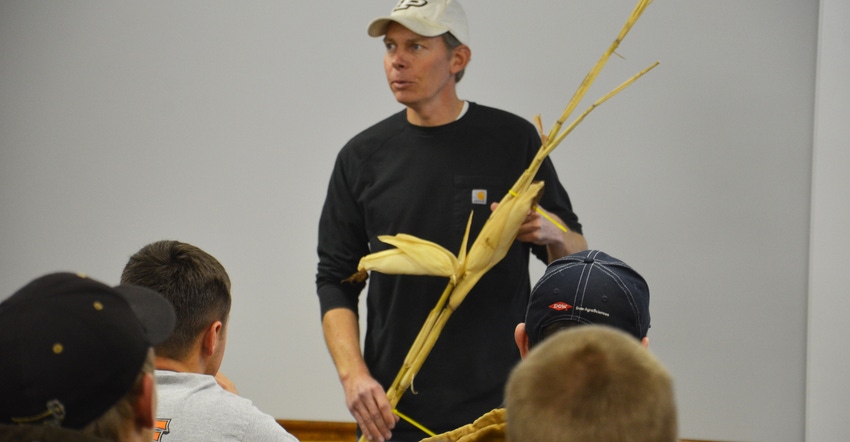
The goal was for FFA members to learn about corn production, marketing and research — all at the same time. It was the inspiration for the FFA Profit Plots program at the Southeast Purdue Agricultural Center this past year. Four FFA chapters each came up with a recipe for producing and marketing corn, and SEPAC staff followed those recipes in replicated plots.
What SEPAC Superintendent Joel Wahlman didn’t count on was how much he and his staff would also learn from the experience.
“It was educational for us, too,” he says. “We saw and learned things that we would not have picked up on otherwise.”
Crop mystery
One of the things the staff learned is a classic tale of how to use crop scouting to solve something you can’t explain. “By midseason, some of the plants in some of one school’s replicated plots were looking abnormal,” Wahlman says. “There was leaf striping, and distance between the nodes seemed close on some plants.
“I decided to use it as a teaching moment and try to figure out what was causing it at the same time. The first step was to pull out the Purdue Corn & Soybean Field Guide and try to find pictures that matched up to what we were seeing,” he says.
Wahlman stopped when he reached the pictures of zinc deficiency. He saw a resemblance to what he was seeing in the field.
Next steps
So that’s it: zinc deficiency. Just add zinc next year and be done with it, right? Wahlman knew a good crop sleuth needed to confirm what was being seen.
“We took tissue samples and sent them to the Purdue Pest and Plant Diagnostic Lab just to rule out disease as a factor,” he says. Results came back negative for disease. Instead, they steered him toward Jim Camberato, Purdue Extension soil fertility specialist.
“He asked lots of questions,” Wahlman says. “One thing different in this plot was that the school’s recipe called for a fairly high amount of starter fertilizer with phosphorus in it. Camberato suggested that if the soil test level for P in the plot was already high, adding that much P as starter might have affected the phosphorus-to-zinc ratio.”
It turns out that the ratio should be 100-to-1 or less. Camberato recommended sending tissue tests to a lab.
Finding answers
“We pulled leaf samples and sent them to a commercial lab,” Wahlman says. “The results came back with the P-to-zinc ratio at 185-to-1 in the leaf tissue — definitely very high.”
Wahlman didn’t stop there. He and his assistant at SEPAC, Alex Helms, pulled soil samples from the plots where they saw symptoms. The samples came back indicating low zinc values.
“We may never know for sure, but the theory is that the high-phosphorus starter fertilizer put too much phosphorus in the soil compared to the amount of zinc. It created a zinc deficiency in some plants,” Wahlman says.
“What we didn’t realize was that P levels were that high in those plots. We all learned something.”
About the Author(s)
You May Also Like




